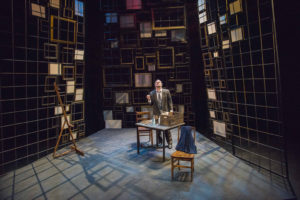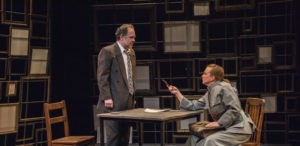
Laura Latreille (left) and Benjamin Evett (right). Photo by Andrew Brilliant/Brilliant Pictures.
By Michele Markarian
The Bakelite Masterpiece – Written by Kate Cayley. Directed by Jim Petosa. Scenic Design by Cristina Todesco; Lighting Design by Scott Pinckney; Sound Design by Dewey Dellay; Costume Design by Molly Trainer. Presented by New Repertory Theatre, 321 Arsenal Street, Watertown through April 8.
If Cristina Todesco’s starkly beautiful set, with its three-sided tower of artwork surrounding a plain wooden desk and two overturned chairs doesn’t immediately draw you into The Bakelite Masterpeice, then the opening line, “Consider Lucifer”, certainly will. Set in 1945 post-war Amsterdam, The Bakelite Masterpiece is based on the true story of art forger Han van Meergeren (Benjamin Evett).
It’s an interesting story. Van Meergeren has been jailed, as a result of having sold a Vermeer entitled “Christ and the Adulteress”, to Nazi officer Hermann Goring, whom he had also entertained, along with other Nazi officers, in his home. Unsympathetic interrogator Geert Piller (Laura Latreille) wants to make an example of van Meergeren by trying him for treason, then shooting him. People are hungry and dispirited, and this act of retribution could provide them with an outlet for their anger.
Van Meergeren pleads his case – he is not a traitor, but a hero, as the so-called Vermeer he sold to the Nazi is a fake. He painted it himself, using Bakelite to harden the paint. To prove it, he asks Piller to allow him to forge another Vermeer, allowing her to choose the subject. Piller agrees, posing for him herself.

Van Meergeren is an unlikely protagonist. He takes frequent hits of morphine, which he is addicted to. He identifies with Lucifer, musing, “God must have loved him, or he wouldn’t have taken the transgression so to heart. Don’t you think?” Yet one understands his bitterness. His dream – ironically, like Hitler’s – was to be a great painter, but success eluded him. He lacks the genius of originality, referring to himself as a “derivative, shallow, second-rate painter”. This failure leads him to his real gift – mimicry. His particular genius is in recreating other people’s work.
Piller has personal reasons for wanting to extinguish van Meergeren, a man she believes to be a Nazi sympathizer. Despite her resolve to prosecute him, she can’t help but be moved by the beauty in what he is able to create. Their unease with one another is the source of the play’s tension; she is the yin to his yang – with a hidden forgery of her own.

Benjamin Evett’s performance is nothing short of tremendous. He brings a ferocity and intelligence to van Meergeren that allows us to identify with his sense of artistic failure and even understand his helpless self-undoing with his addiction. He also takes a lot of credible falls; I was relieved to see him ambulatory and smiling during the curtain call. Laura Latreille is vulnerable and convincing as Piller, the officer that’s been assigned to prosecute von Meergeren. Of the two roles, hers is the harder one, as we are given less of a reason to fully understand her motivation. Van Meergeren is trying to exorcise a lack of genius, which is at the center of his pain. Piller has experienced devastating loss, which makes her harsh and hardened, yet part of her warms to her captor for causes that are unclear. Compassion? Ardor? Art appreciation? Something inside of her gives him the benefit of the doubt, which is necessary for the play to progress, yet why does she do so?
The drama is punctuated with Dewey Dellay’s somber and stark sound design. And the final tableau of captor and captured, entwined, wrecked survivors from the War, is stunning. For more information and tickets, go to: http://www.newrep.org/

